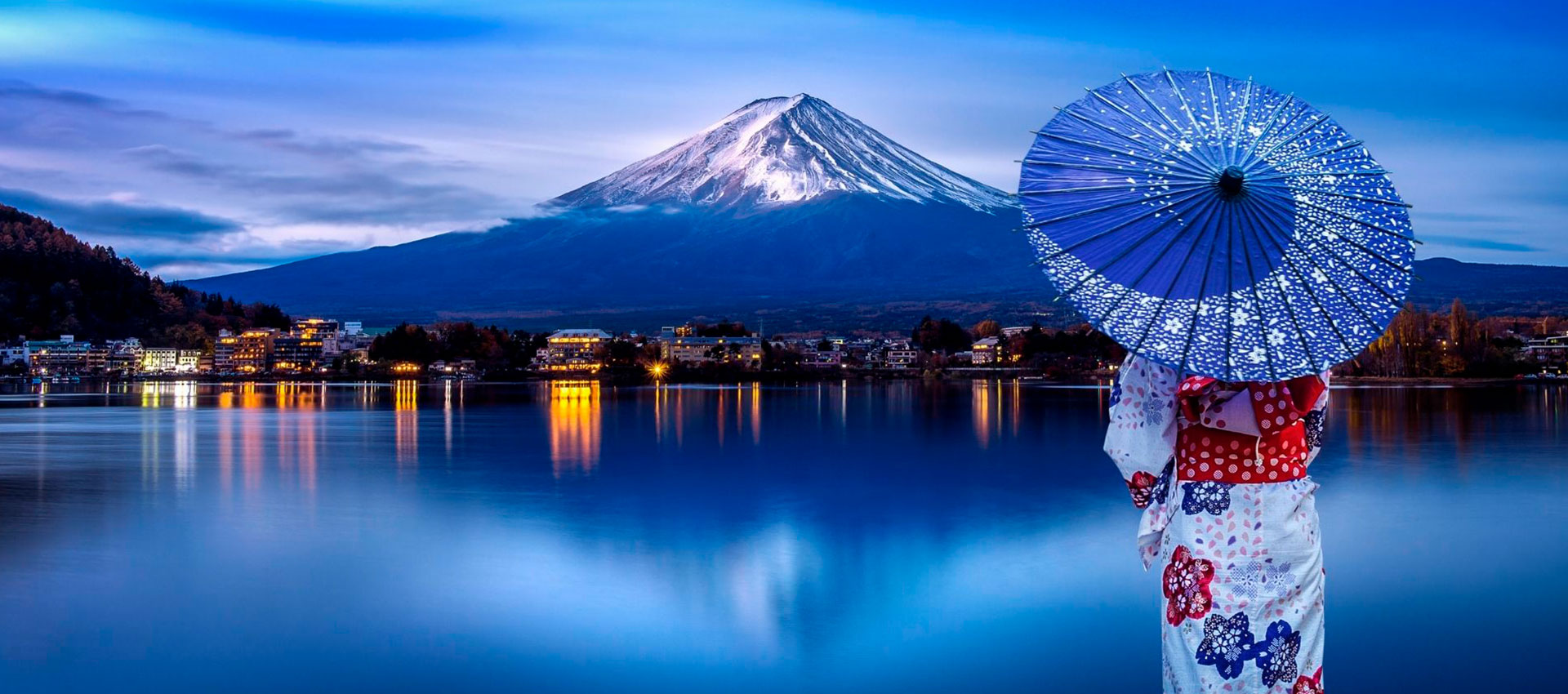
Japan
Japan is a dream destination for travellers, offering a mix of ancient culture, modern cities, and breathtaking landscapes. From exploring Tokyo’s skyscrapers and nightlife to wandering through the historic temples of Kyoto and the food markets of Osaka, every stop feels unique. Nature lovers can hike in the Japanese Alps, relax in hot spring onsen resorts, or time their visit with the famous cherry blossom season. Efficient transport, including the Shinkansen bullet train, makes it easy to cover highlights like Mount Fuji, Nara, and Hiroshima on one trip.
Top Things to Do in Japan
A Dip In Timeless Architecture
Onsen Ryokan are serene retreats where architecture and nature coexist beautifully. Built with wood and stone, these traditional inns feature minimalist designs, shoji screens, tatami floors, and open-air baths, blending seamlessly with their surroundings. Legend says the first onsen was discovered by monks in search of enlightenment, who built ryokan to offer solace to travellers. The baths, fed by geothermal springs, were crafted to harmonize the body with nature. Staying in an onsen ryokan is more than relaxation—it’s an immersion into Japan’s cultural and architectural legacy.
Will you let the soothing waters and timeless design rejuvenate your senses?
Meet the Mystique Entertainers
The mystique of geisha, Japan’s iconic entertainers, dates back to the 18th century. Geisha are skilled in traditional arts like music, dance, and tea ceremonies, embodying grace and refinement. Memoirs of a Geisha by Arthur Golden offers a glimpse into this intricate world, telling the story of Sayuri, a celebrated geisha of Kyoto. The life of Mineko Iwasaki, one of Japan’s most famous geisha, also highlights the dedication and artistry behind this tradition. Today, their presence continues to fascinate, preserving Japan’s artistic legacy.
Are you ready to uncover the enchanting stories behind this timeless tradition?
Sipping Tradition
The Japanese tea ceremony, or chanoyu, is more than a simple act of drinking tea; it is a meditative ritual steeped in harmony and respect. Dating back to the 9th century, this practice was perfected by Zen monks and later refined by tea master Sen no Rikyū in the 16th century. Every movement, from preparing matcha to presenting it, is performed with mindfulness. The aesthetics of the tea room, utensils, and even seasonal flowers are carefully chosen to reflect simplicity and balance.
Would you immerse yourself in this art form that celebrates the beauty of the present moment?
The Capital And The Sacred Deers
Before settling in Nara in 710 CE, Japan’s capital shifted with each new emperor. As the first permanent capital, Nara became the heart of Buddhism and culture, shaping Japan’s identity. The city’s historic treasures, such as the Great Buddha of Tōdai-ji Temple, highlight its significance. Legend says the deity Takemikazuchi arrived on a sacred deer to guard the city, a story honored by Nara’s free-roaming deer, seen as messengers of the gods.
Will you wander through this historic city where tradition and spirituality remain alive?
Of Sakura, Poets, And Hanami
Hanami, the cherished tradition of cherry blossom viewing, is a poetic celebration of life’s fleeting beauty. Rooted in the Heian era, it began with nobles gathering under sakura trees to write poetry inspired by their blossoms. Today, hanami transforms parks into lively havens where families and friends picnic beneath cascades of pink petals. The delicate blooms symbolize renewal and impermanence, a reminder to cherish the present. Legend says the spirits of ancestors reside in these trees, blessing viewers with peace and prosperity. Experiencing hanami is to partake in Japan’s timeless harmony with nature.
Will you marvel at this ephemeral spectacle under the sakura’s graceful embrace?
Japan Travel by Season
Japan’s seasons offer unique experiences, from the delicate cherry blossoms of spring to the vibrant foliage of autumn, each season bringing its own charm. Whether it’s cultural festivals, scenic hikes, or serene winter landscapes, there’s a perfect destination for every season, including Kyoto, Hokkaido, Nikko, and Sapporo.

Haru / Spring Season
March to May
Cherry blossoms paint the landscapes in pastel hues, symbolizing renewal and beauty.
Recommended Destinations:
Kyoto, Tokyo, & Nara

Natsu / Summer Season
June to August
Festivals and lush greenery dominate the season, perfect for cultural celebrations and scenic hikes.
Recommended Destinations:
Hokkaido, Okinawa, & Kamikochi

Aki / Autumn Season
September to November
Fiery foliage transforms the scenery, paired with crisp air for outdoor explorations.
Recommended Destinations:
Nikko, Arashiyama, & Kanazawa

Fuyu / Winter Season
December to February
Snow blankets the country, offering serene landscapes and vibrant winter festivals.
Recommended Destinations:
Sapporo, Shirakawa-go, & Hakuba
Japan Travel: FAQs
What is the best time to visit Japan for travellers?
The best time to visit Japan is during spring (March–May) for cherry blossoms and autumn (September–November) for vibrant foliage. These seasons offer pleasant weather for exploring cities, temples, and gardens. Summer (June–August) is popular for festivals and hikes in the Japanese Alps, while winter (December–February) is perfect for skiing in Hokkaido and experiencing snow festivals.
How many days are enough for Japan?
A week is enough to cover highlights like Tokyo, Kyoto, and Osaka. For a more complete Japan itinerary that includes Hiroshima, Hokkaido, or Okinawa, plan for 12–14 days. Travellers with more time can explore regional gems like Kanazawa, Takayama, and Nara.
What kind of traveller is Japan ideal for?
Japan suits almost every kind of traveller — culture enthusiasts, food lovers, adventure seekers, and families. From high-tech cities to tranquil temples, neon-lit nightlife to mountain villages, Japan offers a balance of tradition and modernity that appeals to solo travellers, couples, and groups alike.
What is Japan famous for?
Japan is famous for its cherry blossoms, Mount Fuji, samurai and geisha traditions, and cutting-edge technology. The country is also renowned for sushi, ramen, and street food, as well as its UNESCO World Heritage temples and shrines. Beyond sightseeing, Japan offers wellness through Zen meditation, onsen hot springs, and monastery stays that provide holistic rejuvenation.
Is Japan part of Asia or the Pacific?
Japan is an island nation in East Asia, located in the Pacific Ocean. While culturally Asian, its unique traditions and innovations make it a distinctive destination that blends ancient heritage with modern living.
Do Indian travellers need a visa to visit Russia?
Yes, Indian travellers need a visa to visit Japan. Tourist visas are typically valid for short stays, with requirements that include confirmed flights, accommodation, and financial proof. Processing is straightforward through the Japanese Embassy or VFS centers in India. Always check the latest guidelines, and refer to the official VFS Japan visa portal.
What currency is used in Japan, and can travellers use credit cards?
The currency of Japan is the Japanese Yen (JPY). While credit cards are widely accepted in hotels, department stores, and restaurants, cash remains essential for small shops, local eateries, and rural areas. ATMs are available at post offices, convenience stores, and major train stations.
What language is spoken in Japan?
The official language of Japan is Japanese. English is understood in tourist areas, hotels, and airports, but communication can be limited in rural regions. Learning a few Japanese phrases or using translation apps can make travel easier.
What local etiquette should travellers follow in Japan?
Japanese culture places strong emphasis on respect and harmony. Bowing is a common greeting, shoes must be removed before entering homes and certain temples, and talking loudly on public transport is discouraged. Tipping is not customary, but politeness and punctuality are highly valued. At restaurants, it’s considered rude to leave food unfinished — though portions are usually modest, so finishing your meal is expected as a sign of respect.
What should travellers know about Japanese food and dietary options?
Japan is a paradise for food lovers, with specialties like sushi, ramen, tempura, and matcha desserts. Street food such as takoyaki and okonomiyaki are must-tries. Vegetarian and vegan travellers may find limited options in traditional eateries, but major cities offer plant-based restaurants and international cuisines.
Is Japan budget-friendly, and how much should travellers budget per day?
Japan is generally considered an expensive destination compared to other parts of Asia. Mid-range travellers should budget around INR 10,000–15,000 per day for accommodation, meals, transport, and entry fees. Budget travellers using hostels, public transport, and convenience-store meals may manage with INR 7,000–9,000 per day, while luxury travellers can easily spend INR 20,000+ daily on ryokan stays, Michelin-star dining, and private tours. Careful planning, rail passes, and local eateries can help make a Japan itinerary more cost-effective.
What are the main airports in Japan for international travellers?
Major airports include Narita and Haneda in Tokyo, Kansai International in Osaka, and Chubu Centrair in Nagoya. Other important airports are in Sapporo, Fukuoka, and Okinawa, providing access to regional destinations.
How easy is it to travel around Japan?
Japan is one of the easiest countries to travel around, thanks to its efficient transport system. The Shinkansen (bullet trains) connect major cities at high speed, while metro systems in Tokyo, Osaka, and Kyoto are convenient and punctual. IC cards like Suica and Pasmo make local travel easy, and domestic flights cover longer routes.
How do tourists travel by train in Japan, and what should they know about booking Shinkansen and other trains?
Train travel in Japan is world-class and a highlight for many visitors. The Shinkansen (bullet trains) are fast, clean, and punctual, connecting cities like Tokyo, Osaka, Kyoto, and Hiroshima in record time. There are also scenic trains, luxury trains, and extensive local networks covering towns and villages.
Japan Railways (JR) operates most long-distance trains, and the Japan Rail Pass offers excellent value for tourists planning multi-city travel. Classes of service include Ordinary, Green (first class), and Gran Class with luxury seating and amenities. Facilities onboard typically include reserved and non-reserved seating, luggage space, and food trolleys.
Tickets can be purchased at stations, online, or via travel agencies, but the language barrier and ticketing systems can be confusing. AEJ recommends booking train travel as part of a planned itinerary, especially for older travellers, to ensure comfort and convenience.
What are the luggage rules on trains in Japan. When or how should travellers use courier services (takuhaibin) for train travel in Japan?
Japan has clear baggage policies for train travel, especially on the Shinkansen (bullet trains). Suitcases larger than 160 cm in combined dimensions (height + width + depth) require an advance reservation for special luggage space. Oversized bags without a reservation may not be allowed on board. Local and regional trains often have limited storage, making large suitcases difficult to manage.
To make travel easier, Japan offers reliable takuhaibin courier services, which deliver luggage between hotels, airports, and even train stations. The service typically costs JPY 2,000–3,000 (₹1,200–1,800) per bag, depending on size and distance, and delivery is usually completed within 24 hours. It is affordable, punctual, and especially useful for families, older travellers, or anyone planning multi-city journeys.
By using takuhaibin, travellers can explore cities with just a day bag, avoiding the hassle of carrying heavy suitcases on crowded platforms and trains. Since the sizes of bags vary, we at AEJ recommend paying for the service directly with the service provider at the hotel who can also recommend the best courier services based on the location.
What is the connectivity like between major cities in Japan?
Connectivity in Japan is excellent. Bullet trains link Tokyo, Osaka, Kyoto, and Hiroshima within hours, while domestic flights serve Hokkaido, Okinawa, and remote islands. Buses are also reliable for regional travel, making it easy to plan a multi-city Japan itinerary.
Discover our carefully curated selection of itineraries to indulge your happy feet. Embark on a journey of discovery in the most intimate setting tailored to your travel needs.
Inspired by what you see? Connect with us to design a meticulously curated journey with our travel ARTHitect — the journey of your dreams is just a conversation away.
